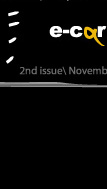Narvika Bovcon & Aleš Vaupotic
Authors:
Narvika Bovcon kino_log@hotmail.com, Aleš Vaupotic alesoooo@yahoo.com;
(home www.geocities.com/kino_log)
Ljubljana, Slovenija
Title:
VideoSpace: An Artistic Archive
(project home http://black.fri.uni-lj.si/videospace/)
VideoSpace was created on the basis of three projects: Javornik (2001), R
III (2002) and VSA (2003). These are autonomous artistic projects (that have
been exhibited also separately), which should be conceived through the viewpoint
of video-integrated media and conceptual art. Each of the three projects and
of course their relationships (alliance) in VideoSpace are realised through
multiple artistic media: as video tape, video installation and web site, in
some cases also as an interactive CD-ROM (Javornik), traditional paintings
acrylic on canvas (R III) and corporate identity (VSA). VideoSpace is realized
on different levels, too: first as a conceptual diagram, than as an interactive
CD-ROM with a virtual three-dimensional hyperspace and as a reduction of the
CD-ROM version into the language of VRML three-dimensional net reality.
Three autonomous projects in the VideoSpace are connected to each other by
the conceptual horizon that defines each of them and all of them in relation
to each other. This is a triad of irreducible cosmic substances: the matter,
the human and the language. With this triad we are able to overcome some of
the crucial contemporary philosophical biases embodied in critical movements
- as for example formalism (that functions only in the field of language and
to some extent in the field of matter), psychologism (with the human expressiveness
through language), historical materialism and neomarksisms… - of course
in the theoretical form enabled by the metalinguistics of Mikhail Bakhtin
and the archaeology of Michael Foucault. In the three projects all three substances
are intertwined on the artistically specific level: the language is considered
from the point of view of literary sciences and intertextuality, the human
through the theories and practices of body art and performance, the matter
through Bakhtin's and Foucault's theories of the materiality of discourse.
Language is in the focus of the project R III, which is actually a transposition
of Shakespeare's history play King Richard the Third into the medium of videotape.
Today King Richard the Third is perceived mainly as a discursive field that
transgresses the mere problematics of literary intertextuality and extends
into the field of material effects that interfere with human life in the form
of politics. Javornik explores the borders of body art, which despite its
apparently transparent aim turns out to be not as non-problematic as it may
seam. Activation of unpleasant connotations of artistic discourses and institutions
shatters the very institution of artistic abuse of the body. The VSA project
is focused on the materiality, it searches for the contact with the matter
in its pure form. However, this contact is not non-problematic but instead
it appears wrapped into a Kafka-like maze of discourses and institutions.
In VideoSpace we followed the logic of the triad language, human, matter and
we added the spatial dimension. This move is suggested in the theoretical
shift enabled by the theories of Mikhail Bakhtin and Michael Foucault. Foucault
somewhere clearly states that the shift of the philosophical research from
the problematics of time onto the problematics of space relations is necessary.
The teritorialization of the discourse has replaced the deconstructionist
or Lacanian burgeoning of the discourse from the rapture in time. Since we
are dealing with computer media, we evolved our concept mainly from the model
of the hypertext, that is, by means of links spreading through the internet,
and from the model of video games, that contribute the three dimensional graphics
- some kind of hyperspace -, which appears before our eyes in real time.
On the level of conceptual diagram we added to the three projects also the
context of the video game Tomb Raider, which makes use of the third person
gaze, attached to the model of our double, the avatar. The space with which
Lara Croft communicates and interacts is mainly a representation of the real
space. In the CD-ROM version, when we have faced the concrete dilemma about
what the virtual space should look like in order to enable the coexistence
and mutual functioning of the three projects, the shift of the player's interest
from the avatar to the space itself was necessary. That is because the avatar
implies the connection of the tactile qualities of the space details with
the user, who relates to the virtual space through the experience of his/her
own physical body in the real space. The meaning of the avatar in the video
game is that it as a perfect double of the user takes over his/her complete
interest and thereby it disqualifies the spatial features of the game (eg.
video game Tekken). Since the triangular relatiogram of the world is developed
on the conceptual level and since it addresses the user completely on the
conceptual level, too (and not on the level of physical experience), the avatar
as the strongest carrier of identification becomes unnecessary and even disturbing,
since the user strolls in the conceptual space with the aim to discover the
space and not to experience it as his home. By absence of the experimental
manipulability of the space features the empirical distance is evolved between
the user and the virtual space, the consequence of which is the shift into
the conceptual understanding.
The virtual space of VideoSpace is founded in three elements: the three dimensional
objects, the two dimensional textures and the interested gaze which explores
the space. Each of the elements is developed through its crucial perceptive
aspect: three-dimensional objects mimics the three-dimensional objects from
the real space (eg. the house), textures are not mimetically applied to the
objects they cover (e.g. The texture of wall bricks is not applied to the
object of the house), instead they claim the two-dimensionality, whereas the
interested gaze is focused into the space itself and it does not disclose
its carrier, the avatar. The three dimensional objects and the two dimensional
textures are thereby functional in their specific roles and not in the common
role of an illusion of the real world. This is in part possible because the
three dimensional objects carry enough information about the references to
the real world by their three dimensional form alone and would be therefore
redundantly codified if they would mimic real world also on the level of textures.
The textures are utterly flat, two-dimensional when they carry pornographic
images. In fact, the meaning or the story of any image takes place in the
point of its suspense, the maculae. This is the point, which is not directly,
or onefoldedly interpreted; it is the point of the submersion of the viewer
into the image. A pornographical picture has no such point since it discloses
everything. It has no suspense; its first meaning is at the same time also
its last and all the meanings in between. It shows to the gaze what the gaze
is looking for and the finding of which should never occur in order for the
search of the interested gaze to be possible. However, we must not get to
think that the pornographic image is a privileged image that shows a reality
more real than all the other images. In fact, it is just one of many images
that are flattened by means of social, political and cultural censorship and
manipulation. It gains its unpleasant impact on the viewer only through these
censorships and manipulation and not on itself or from its privileged content.
One example of such disturbing, manipulated and thus flattened images is the
FBI web site for the most wanted terrorists. The photographs of the terrorists
on the web site are manipulated with Photoshop effect that makes the photo
look old and damaged and thus it implies the violent character of the person
on the photo - the person that is designate as a terrorist also through the
manipulative means of photographic image. The world of terrorists is censored
and presented as a violent, uncivilised world, of which such photos are the
evidence.
Each of the three elements of the VideoSpace (objects, textures, interested
view) could not exist without the other two and every two of them without
the third could not form the logic of the virtual space. The segmentation
of the virtual space into the crucial perceptive functions of the elements
that form it has been the foundation for the understanding, conceptualising
and designing the form and the way of codification of each of them. Hence,
here we have a conceptual virtual space, the task of which is not to mimic
the real world at the resolution as high as possible (as are the trends in
contemporary video games), but rather to evolve an environment into which
the triangular relatiogram of the world can be placed and developed by the
means of the three projects Javornik, R III and VSA.
The VRML version of the VideoSpace (http://black.fri.uni-lj.si/videospace/)
is reduced to a platform in the black infinite space and the conceptual triad
of the relatiogram language, human, matter juxtaposed with the triad of the
projects Javornik, R III and VSA. The space in the virtual reality of the
VRML code is functionally reduced to the minimal possible information in order
not to overload the internet data transfer. The platform in the black space
is manipulated by means of the possible movements in the virtual space: the
translation with the functions of zoom in and zoom out, and the rotation of
the object (the platform). Each of these manipulations creates a travelling
in the space, whereas through travelling different points of view and interest
are created and discovered. Thereby the user gradually approaches the relatiogram:
he/she can grasp it from a distance by zooming out or proceed from one mapped
identity point to another. Each of the identity points is linked to the web
pages of the project in concern. Thus the spatially mapped relatiogram is
transferred to a parallel level of separate pages by the instantaneous action
of the web links. The linked pages may be considered flat in comparison to
the three dimensional translations in the virtual reality of the VRML VideoSpace.
This is one way of exiting and re-entering the virtual space of VideoSpace;
the other is the disclosure of the symbol of the relatiogram, which is the
Star of David. It is the point of leakage of the virtual space into the real
world space of a specific social context that cannot be perceived as a neutral
appendix but instead it modifies the self-contained structure of the virtual
reality and makes it dependent on and a part of the social network of discourses.
|
|
|
||||||||||||||||||||||||||||
|
|
 |
|
|
||||||||||||||||||||||||||
 |
 |
|
|
||||||||||||||||||||||||||
 |
 |
|
|
||||||||||||||||||||||||||
 |
 |
 |
|
||||||||||||||||||||||||||
|
|
|
|
|||||||||||||||||||||||||||
|
|
 |
|
|
||||||||||||||||||||||||||
|
|
 |
 |
|
||||||||||||||||||||||||||
|
|
 |
|
|
||||||||||||||||||||||||||
 |
|
||||||||||||||||||||||||||||
 |
|
||||||||||||||||||||||||||||
 |
|
||||||||||||||||||||||||||||
|
|
|
||||||||||||||||||||||||||||
|
|
|
|
|
||||||||||||||||||||||||||
|
|
|
|
|
||||||||||||||||||||||||||
|
|
|
|
|
||||||||||||||||||||||||||
|
|
 |
 |
|
||||||||||||||||||||||||||
|
|
|
||||||||||||||||||||||||||||
| |
 |
|
|||||||||||||||||||||||||||
|
|
|
||||||||||||||||||||||||||||
|
|
|
||||||||||||||||||||||||||||
|
|
|
||||||||||||||||||||||||||||
|
|
|
||||||||||||||||||||||||||||
 |
|
 |
 |
|
|
||||||||||||||||||||||||
|
|
 |
|
|
||||||||||||||||||||||||||
 |
 |
|
|||||||||||||||||||||||||||
 |
|
||||||||||||||||||||||||||||
|
|
|
||||||||||||||||||||||||||||
|
|
|
|
|
|
|
|
|
|
|
|
|
|
|
|
|
|
|
|
|
|
|
|
|
|
|
|
|
|
|